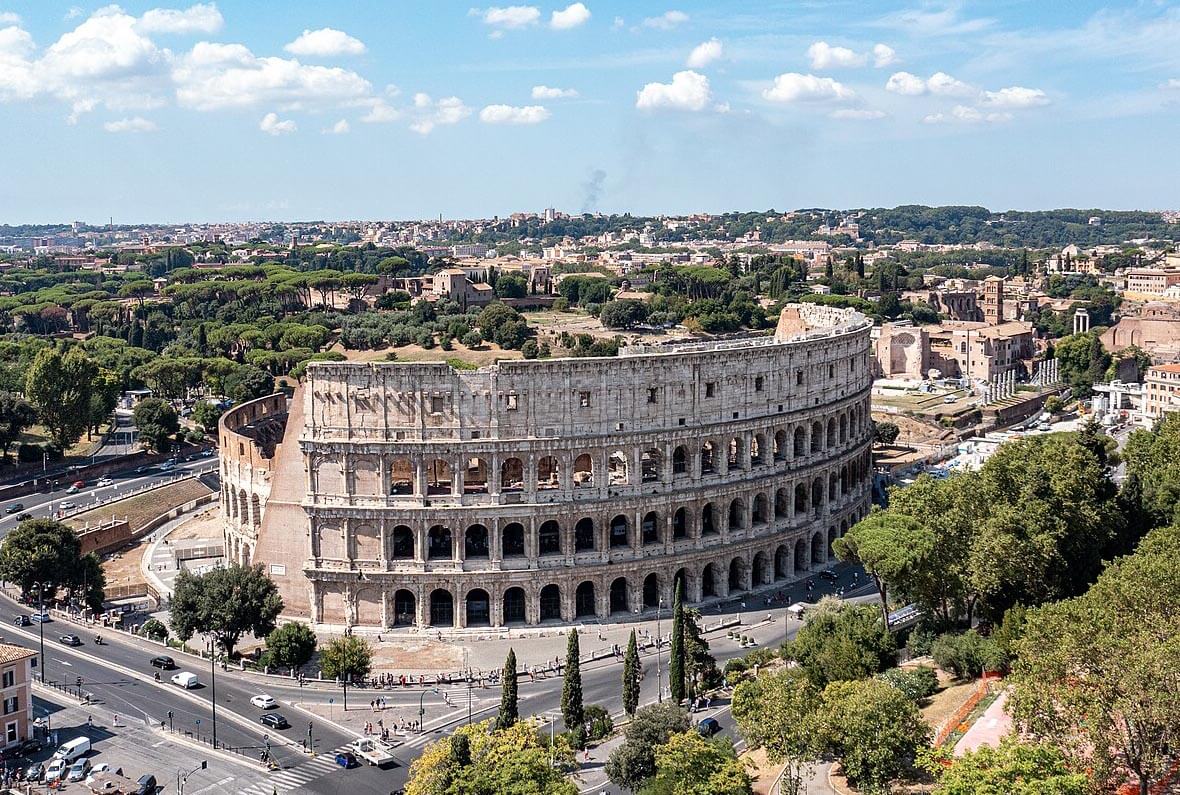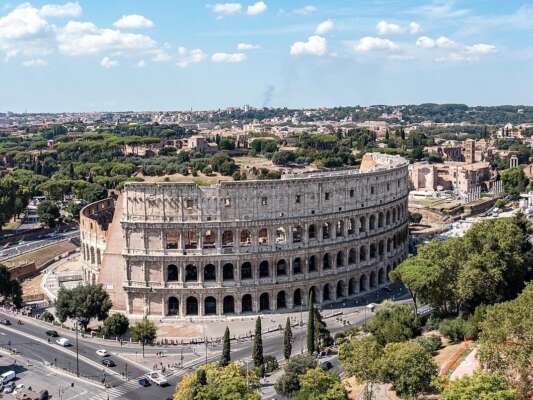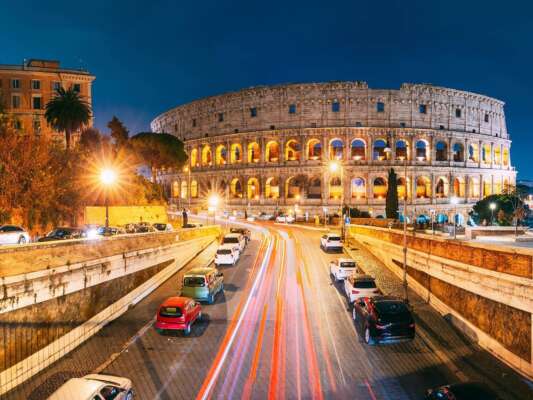In this free guide, you will learn about the Roman Colosseum, also known as the Flavian Amphitheatre, which is an oval arena located in the center of Rome, Italy, just east of the Roman Forum. It is the largest amphitheater constructed by the ancient Romans and remains the largest standing amphitheater in the world.
Colosseum – Full Free Guide
Editor’s Choice
Vatican City Free Audio Guide
Notre-Dame de Paris Free Audio Guide
Louvre in Paris – Free Audio Guide
Since 2000, the night illumination of the Colosseum has been changed from white to gold to symbolize the international campaign against capital punishment. This occurs whenever a death sentence is commuted or a jurisdiction abolishes the death penalty.
Situated in the heart of Rome, Italy, to the east of the Roman Forum stands the Colosseum, an iconic structure recognized for its oval shape. This amphitheater, the largest of its kind ever constructed in antiquity, continues to hold the record for the world’s most massive amphitheater that remains standing, despite its historical age. Annually, the Colosseum attracts approximately 6 million visitors. Prospective visitors are advised to purchase tickets online in advance. Legend has it that Emperor Titus marked the opening of the Colosseum with a hundred consecutive days of festivities, which regrettably resulted in the death of over two thousand gladiators and in excess of nine thousand wild beasts. The amphitheater was in use for over five centuries, with the final games recorded in history taking place in the 6th century. An interesting architectural note is that the Vancouver Public Library in British Columbia, designed by Moshe Safdie, shares a resemblance with the current form of the Colosseum. Its construction began under Emperor Vespasian in 72 AD and reached completion under his successor, Titus, in 80 AD. Further enhancements were made during Domitian’s rule. Collectively, these three emperors form the Flavian dynasty, leading to the amphitheater’s original designation as the Flavian Amphitheatre by later historians due to its association with their family name, Flavius. The structure’s imposing stature stands at 157 feet or 48 meters tall, with a foundational area covering 6 acres or approximately 24 thousand square meters. This means it towers over a 16-story building and can accommodate more than three football fields within its expanse. Constructed primarily of travertine limestone, tuff volcanic rock, and brick-faced concrete, the Colosseum was designed to hold between 50 thousand to 80 thousand spectators, averaging around 65 thousand attendees. It hosted a variety of events including gladiatorial contests, public spectacles such as animal hunts, executions, re-enactments of famous battles, dramas based on Roman mythology, and even, for a brief period, mock sea battles. Following its peak era of entertainment, the Colosseum fell into disuse during the early medieval period and was subsequently repurposed for various functions including housing, workshops, a religious order’s quarters, a fortress, a quarry, and a Christian shrine. Although it has been significantly damaged by earthquakes and stone looters, the Colosseum endures as an emblematic symbol of Imperial Rome and is recognized as one of the New 7 Wonders of the World. As one of Rome’s leading tourist destinations, it also holds a connection to the Roman Catholic Church, with the Pope leading a torchlit “Way of the Cross” procession on Good Friday beginning in the vicinity of the Colosseum. The Italian five-cent euro coin proudly features an image of the Colosseum. In its early days, it was simply known as amphitheatrum in Latin. The contemporary name “Flavian Amphitheatre” is widely used, although there is no classical antiquity evidence to support this name historically.
The origin of the Colosseum’s name is thought to be linked to a massive statue of Nero, fashioned after the Colossus of Rhodes. This enormous bronze depiction of Nero as a sun god was relocated next to the amphitheater by Emperor Hadrian. The term ‘colosseum’ comes from the Latin word ‘colosseus’, which means ‘enormous’ or ‘mammoth’. After Nero’s demise and subsequent civil unrest, the Colossus statue was modified to resemble Helios or Apollo, complete with a solar crown, and it was then commonly called “Colossus solis”. The heads of the statue were replaced with those of successive emperors. However, the statue eventually toppled, likely to repurpose its bronze, and over time it was largely forgotten, with only its base remaining near the Colosseum and the Temple of Venus and Roma.
The Colosseum’s history begins with Emperor Nero, who, after the great fire of Rome, built his extravagant Golden House at the site in 64 AD. In front of it, he fashioned an artificial lake encircled by pavilions, gardens, and porticoes. The existing “Aqua Claudia” aqueduct was extended to supply water to the area, and the grand bronze Colossus of Nero was placed nearby. While the statue was preserved, much of the Golden House was demolished, the lake filled in, and the land repurposed for the new Flavian Amphitheatre. The location also housed gladiatorial schools and other support structures on what was once the Golden House grounds.
Emperor Vespasian’s decision to erect the Colosseum on Nero’s former lake can be seen as an act of returning to the people a part of the city that Nero had claimed for his personal enjoyment. Unlike many other amphitheaters which were constructed on the outskirts, the Colosseum was strategically placed at the epicenter of Rome, symbolically and physically reinforcing its significance. It is said that Vespasian commissioned the Colosseum using the spoils of war from the Jewish-Roman War after the 70 AD siege of Jerusalem.
The Colosseum’s construction was a showcase of Roman engineering prowess, drawing upon the expertise of a variety of professionals including builders, engineers, artists, painters, and decorators. A diverse range of materials such as wood, limestone, tuff, tiles, cement, and mortar were utilized in its assembly. The ambitious project initiated during Vespasian’s reign around 70 AD, had made significant progress by the time of his death in 79 AD, with construction continuing under his son Titus. The completed upper level was inaugurated with games in 80 AD, where Dio Cassius documents the killing of over nine thousand wild beasts.
Subsequent remodeling efforts were undertaken by Domitian, Vespasian’s younger son, who not only enhanced the amphitheater with a hypogeum—a complex of underground tunnels for animals and slaves—but also expanded the seating area. However, the structure suffered considerable damage in a severe fire in 217, which led to extensive repairs over the next century, including after significant earthquakes.
The Colosseum witnessed its last gladiatorial combats around the mid-5th century, though animal hunts persisted into the early 6th century. During the medieval era, the edifice experienced a transformation in use, with parts of it serving as a chapel, a burial ground, and even residential and commercial spaces. Notably, by the 12th century, areas beneath the seating galleries were still being leased out.
In the dawn of the 13th century, the Colosseum was claimed by the Frangipani family, who fortified it, effectively turning it into a stronghold. During the early to mid-1300s, as the papacy relocated to Avignon, Rome’s population dwindled, leading to a rise in insecurity. Consequently, the Colosseum, now largely neglected, became a refuge for bandits. The great earthquake of the 14th century further devastated the structure, particularly affecting the outer southern side, which rested on unstable soil. The rubble from the collapse was repurposed to construct various edifices throughout Rome. Later, after the papacy’s return to Rome, the Colosseum saw a form of rebirth through the efforts of a religious order that inhabited it until the early 19th century. The interior faced extensive stone stripping, some of which was burned to create quicklime, while the iron clamps that held the stonework together were extracted, leaving the structure scarred with pockmarks.
During the 16th and 17th centuries, church authorities contemplated repurposing the Colosseum. Pope Sixtus V proposed transforming it into a wool factory to employ Rome’s courtesans, but the plan was abandoned after his death. Cardinal Altieri later entertained the idea of staging bullfights within the arena, but public dissent forced the quick abandonment of such plans.
By the mid-18th century, the Church had recognized the Colosseum as a sacred site, believed to be the place of martyrdom for early Christians. Pope Benedict XIV forbade further desecration of the structure and consecrated it to the Passion of Christ, installing Stations of the Cross and declaring it hallowed by the blood of the martyrs. Successive popes initiated various stabilization and restoration projects, removing the encroaching vegetation that threatened additional harm to the structure. The façade received structural reinforcement in the early 19th century, with further interior restorations following in the 1930s.
Today, the Colosseum stands as one of Rome’s most frequented tourist destinations, attracting millions of visitors yearly.
In more contemporary times, the Colosseum has become emblematic of the international fight against capital punishment. In Italy, where the death penalty was abolished in 1948, this ancient structure has witnessed numerous protests advocating for the end of capital punishment globally. Commencing in 2000, the Colosseum has served as a potent symbol during these demonstrations. In a powerful statement against the death penalty, the lights that bathe the Colosseum at night shift from white to gold whenever a death sentence is overturned, a condemned prisoner is released, or a country abolishes the death penalty entirely. This last occurred in November 2012 to celebrate Connecticut’s repeal of the death penalty in April of that same year.
Although the Colosseum’s ruined interior precludes it from hosting large-scale events, a limited audience can still gather within its confines on temporary seating for certain occasions. Yet, its exterior continues to serve as a grand backdrop for major concerts. Over the years, this historic venue has featured performances by illustrious artists including Ray Charles, Paul McCartney, Elton John, and Billy Joel.
The Colosseum today stands not only as a monument of ancient Rome but also as a vibrant cultural site. It houses a museum dedicated to Eros within its upper tier and has partially restored its arena floor. Since 2010, visitors have been able to explore the network of underground passageways once used to transport animals and gladiators to the arena. The Colosseum also remains a focal point for Roman Catholic events; for instance, Pope Benedict XVI led the Scriptural Way of the Cross procession there on Good Fridays in recent years.
Enjoy listening to our Colosseum free guide. Comment below and join our social media: YouTube, Instagram, and Facebook.




